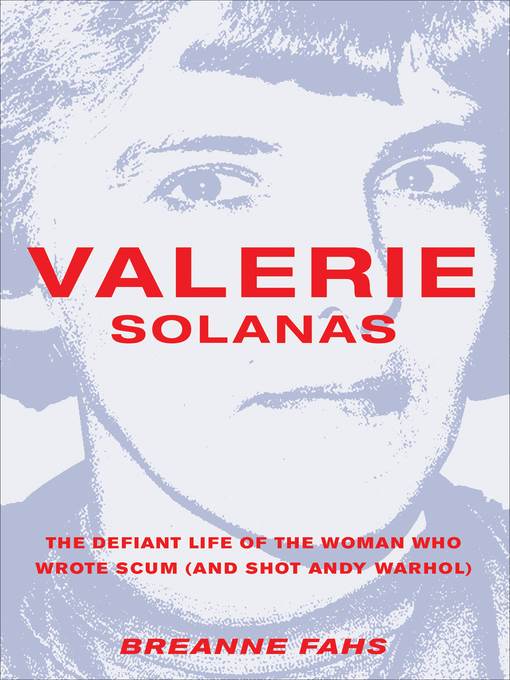
Valerie Solanas
The Defiant Life of the Woman Who Wrote Scum (and Shot Andy Warhol)
- اطلاعات
- نقد و بررسی
- دیدگاه کاربران
نقد و بررسی

February 24, 2014
Fahs (Performing Sex), director of Arizona State University’s Feminist Research on Gender and Sexuality Group, offers a straightforward, engaging, and comprehensive biography of Valerie Solanas, author of the SCUM Manifesto and notorious as the woman who shot Andy Warhol. Rather than focusing on the Warhol shooting, Fahs gives a refreshing degree of weight to not only SCUM Manifesto—and its contribution to the birth of radical feminism—but also to Solanas’s earlier writings and creative pursuits, such as her playwriting and attempts at publishing in periodicals. Fahs, who interviewed her subject’s family, friends, enemies, as well as Warhol associates, doesn’t shy away from how hated and feared Solanas was by many feminists of the era, such as Betty Friedan, but she portrays Solanas as melancholy, warm, and emotionally broken, as well as violent and combative. While some characters pop up and drop away depending on their relevance to Solanas’s life in the moment, giving a disjointed feel to the narrative, Fahs ably fills a notable gap in feminist history with this accessible volume. 36 b&w photos.

March 1, 2014
A sympathetic biography of a troubled and troubling woman. On June 3, 1968, Valerie Solanas (1936-1988) shot Andy Warhol, almost fatally wounding him. That act and her writing of a feminist manifesto titled SCUM (Society for Cutting Up Men) made her a cult heroine in her own time. Fahs (Gender Studies/Arizona State Univ.; Performing Sex: The Making and Unmaking of Women's Erotic Lives, 2011, etc.), believing Solanas to be a brilliant and "startling prescient," faced considerable challenges in working on this biography: Solanas' mother burned her daughter's papers after Valerie died, and many who knew her refused to talk with Fahs. "Valerie famously rejected, alienated, and repeatedly threatened to kill nearly every friend she had," writes the author. A polarizing figure, Solanas was championed by such feminists as Ti-Grace Atkinson and Florynce Kennedy, the lawyer who defended her for attempted murder, but was reviled by others. The National Organization for Women, founded in 1966, was divided about associating itself with her. A radical faction interpreted Solanas' act as revolutionary, "a symbol of women's rage." Liberal feminists, focused on abortion rights reform, saw the enraged, violent Solanas as "NOW's worst nightmare." For her part, Solanas vehemently rejected expressions of solidarity. "SCUM is for whores, dykes, criminals, homicidal maniacs," she wrote to Atkinson, who had praised the manifesto. "Therefore, please refrain from commenting on SCUM + from 'defending' me. I already have an excess of 'friends' out there who are suffocating me." Diagnosed as a paranoid schizophrenic after the shooting, Solanas descended ever more deeply into madness, spending her last 20 years in and out of mental hospitals. She claimed that a transmitter had been planted in her uterus and that an entity she called "the Mob" was after her. She died impoverished and alone. As Fahs portrays her, Solanas emerges less as "a woman who detected a spirit of collective anguish" than as a woman destroyed by her own overpowering demons.
COPYRIGHT(2014) Kirkus Reviews, ALL RIGHTS RESERVED.

March 1, 2014
Fahs (director, Feminist Research on Gender and Sexuality Group, Arizona State Univ.) has written a well-researched, wrenching biography of Valerie Solanas, author of SCUM Manifesto, but perhaps best known as the woman who shot Andy Warhol. SCUM, the Society for Cutting Up Men, was the brainchild of Solanas, a brilliant but unstable protofeminist who influenced the Sixties radical scene in New York. An "out" lesbian and victim of childhood sexual abuse, she was a passionate walking contradiction, advocating elimination of men while, at times, sharing loving relationships with boyfriends. Incontrovertibly, though, Solanas identified with her manifesto, revising it for years, as she ranted against deceitful conspirators impeding publication of its "correct" version. Homeless and penniless for much of her life, Solanas eventually descended into paranoid madness, dying alone in a San Francisco flophouse 20 years after her assault on Warhol. VERDICT A good companion to the 1996 film I Shot Andy Warhol, directed and written (with Daniel Minahan and others) by Mary Harron, this title will be of interest to feminist historians. Generally, this is a sad, riveting, and important political biography of a significant early fringe feminist.--Lynne Maxwell, West Virginia Univ. Coll. of Law Lib., Morgantown
Copyright 2014 Library Journal, LLC Used with permission.

April 15, 2014
The radical feminist author Valerie Solanas (19361988) ensured her fifteen-minutes of fame when she shot artist Andy Warhol in his New York studio in 1968. The shooting brought notoriety to Solanas' SCUM Manifesto, a brash, aggressive, and startling touchstone for feminism, which celebrated gender dystopia and urged total government overthrow as well as the complete elimination of the male sex. Biographer Fahs recounts the way Solanas symbolized the anger and contentious climate of the era's sexual politics and, through her public trial, became a polarizing force for NOW and the feminist movement. Relying on letters and first-person interviews, Fahs thoroughly traces the fractured narrative of Solanas' life and her ongoing mental illness, while never dismissing the fiery brilliance of her ideas. We follow Solanas from prostitution at the Chelsea Hotel to incarceration at Bellevue Hospital; from Black Panther meetings to performances at Warhol's Factory and publishing negotiations at the Village Voice. Fahs' account paints a vivid picture of the chaotic 1960s milieu, paralleling Solanas' personal struggles with the seeming collective madness of her counterculture setting.(Reprinted with permission of Booklist, copyright 2014, American Library Association.)




دیدگاه کاربران